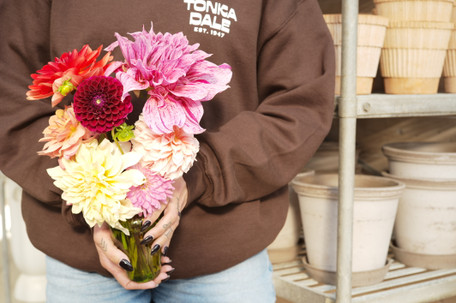Lifting and Dividing Dahlias for Winter Storage
Posted by Amaya Fairbanks on Oct 5th 2025
Lifting and Dividing Dahlias Bulbs for Winter Storage
Dahlias are easy to grow, and come in a full range of amazing colors, shapes, and sizes. Their showstopping blooms and endless variety are a must in cut-flower bouquets. Dahlias bloom from mid-summer through the first fall frost and produce both blooms and tubers so abundantly they demand to be shared. Once you’ve been bitten by the dahlia bug, there’s no going back!
About Dahlias
Dahlias are tubers and are classified as a summer or tender bulb, a term that includes true bulbs, corms, tubers, rhizomes and tuberous roots. Tender bulbs are planted for summer blooms and lifted in the fall as they are not sufficiently hardy to survive through winter temperatures in Minnesota. To read about lifting other summer bulbs, click here!
If ypu lan to save tubers from year to year, you can rapidly increase your stock by digging and dividing them each fall. When a fall frost looms in the forecast, typically around mid-October, consider preparing to dig up or "lift" your tubers.
Lifting Dahlias
- Gather dahlia tags or ID labels - this is important!
- Untie stalks & stems from their support system.
- Prune stems to 6 inches above the soil level.
- Dig wide to avoid damaging the tuber! Use a shovel to loosen soil, lift tubers out of the ground with a garden fork to avoid damaging tubers.
- Match each tuber with its ID tag or relabel.
- Gently brush off the dirt with your hands or a soft brush, then rinse.
- Let dry overnight to cure - wet tubers cause rot, shriveled tubers aren't viable.
Dividing Dahlias
Each tuber will need to be attached to a piece of the main stem, or the “neck” of the plant. Also, each individual tuber will need an eye to produce in the spring.
- Use a clean (sanitized) pair of shears or sharp scissors.
- It can be difficult to identify each eye on tubers in the fall; when spring arrives eyes will become visible as shoots emerge.
- Save all tuber divisions then discard any that lack eyes in the spring.
- Tuber shape varies greatly. Some are easily split into several pieces; others are so tangled that storing them whole may be the best option.
- Broken or damaged parts of tubers are not viable.
Storing Dahlia Bulbs
Once clean and dry, the American Dahlia Society recommends dahlias are stored wrapped in plastic wrap.
- Roll individual tubers in plastic wrap, adding tubers of the same type as you go.
- Layers of plastic keep tubers from drying out and ensures that if one tuber rots others will not be affected.
- Label your tubers after they are all bundled up
- Store in an open box in a dark, cool basement or closet - ideal temperature is 45 F - 50 F.
- Check tubers throughout the winter and make adjustments as needed.
- Discard rotten or shriveled tubers.
Think Spring
In the spring, tuber eyes produce small buds where new growth begins. If a tuber does not have an eye, it is not viable. Many tubers will have multiple eyes. If any were stored as whole tubers in the fall, now is the time to split them. As a reminder, each split needs three things: a tuber, an eye, and part of the neck.
Taking a little bit of extra time in the fall to lift, divide, and store your dahlias is not only cost-effective but incredibly rewarding! You can easily multiply your stock every year with these simple preservation tips.

